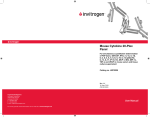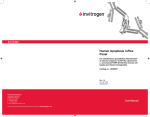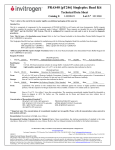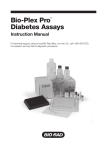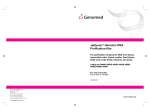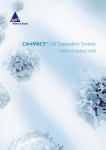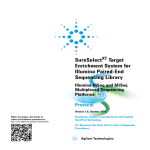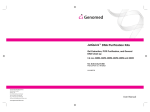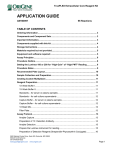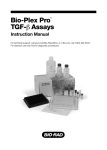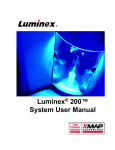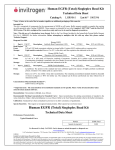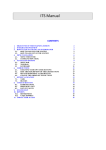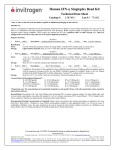Download Cytokine Monkey Magnetic 28-Plex Panel
Transcript
Cytokine Monkey Magnetic 28-Plex Panel For simultaneous quantitative determination of EGF, Eotaxin, FGF-basic, G-CSF, GM-CSF, HGF, IFN-γ, IL-1, IL-1RA, IL-2, IL-4, IL-5, IL-6, IL-8, IL-10, IL-12, IL-15, IL-17, I-TAC, MCP-1, MDC, MIF, MIG, MIP-1, MIP-1, RANTES, TNF-, and VEGF in Rhesus monkey and Cynomolgus monkey serum, plasma, and tissue culture supernatant Catalog no. LPC0003M Rev. 0.0 08 July 2010 PRLPC0003M Corporate Headquarters Invitrogen Corporation 1600 Faraday Avenue Carlsbad, CA 92008 T: 1 760 603 7200 F: 1 760 602 6500 E: [email protected] For country-specific contact information visit our web site at www.invitrogen.com User Manual Table of Contents Table of Contents......................................................................................................iii Kit Contents and Storage .......................................................................................... iv Introduction.................................................................................. 1 Overview ................................................................................................................... 1 Before Starting........................................................................................................... 4 Preparing Reagents .................................................................................................... 7 Assay Procedure ...................................................................................................... 11 Instrument Setup...................................................................................................... 19 Performance Characteristics and Limitations of the Procedure ............................... 20 Troubleshooting....................................................................................................... 21 Appendix .................................................................................... 24 Technical Support.................................................................................................... 24 Purchaser Notification ............................................................................................. 25 References ............................................................................................................... 26 Protocol Summary ................................................................................................... 27 Plate Plan Template ................................................................................................. 28 Explanation of Symbols........................................................................................... 29 iii Kit Contents and Storage Storage All components of the Cytokine Monkey Magnetic 28-Plex Panel are shipped at 2 to 8°C. Upon receipt, store all kit components at 2 to 8°C. Do not freeze. Contents The components and amounts included in the Cytokine Monkey Magnetic 28-Plex Panel are listed below. Reagents Provided 100 Test Kit Cytokine Monkey Magnetic 28-Plex Antibody Bead Solution (1X) 2.5 mL × 1 vial (contains 0.05% sodium azide) Cytokine Monkey Magnetic 28-Plex Biotinylated Antibody Concentrate (10X) (contains 0.1% sodium azide) 1 mL × 1 vial Cytokine Monkey 14-Plex Standard (contains 0.1% sodium azide) 2 vials Cytokine Monkey 15-Plex Standard (contains 0.1% sodium azide) 2 vials Wash Solution Concentrate (20X) (contains 0.1% sodium azide) 15 mL × 1 bottle Assay Diluent (contains 0.1% sodium azide) 15 mL × 1 bottle Incubation Buffer (contains 0.05% sodium azide) 12 mL × 1 bottle Biotin Diluent (contains 3.3 mM thymol) 12 mL × 1 bottle Streptavidin-RPE Concentrate (10X) (contains 0.1% sodium azide) 1 mL × 1 vial Streptavidin-RPE Diluent (contains 3.3 mM thymol) 12 mL × 1 bottle 96-well Filter Plate 1 x 96-well plate 96-well Flat Bottom Plate 1 x 96-well plate iv Introduction Overview Purpose Invitrogen’s Multiplex Bead Immunoassay Kits are developed to maximize flexibility in experimental design, permitting the measurement of one or multiple proteins in panels designed by the researcher. The Cytokine Monkey Magnetic 28-Plex Panel contains all the reagents that are intended for use with the Luminex® 100™, 200™ or FlexMAP 3D® dual laser detection system with xPONENT® software. These instruments are manufactured by Luminex Corporation and are sold by Invitrogen and other vendors. For Research Use Only. CAUTION: Not for human or animal therapeutic or diagnostic use. Background Information Advances in the field of cell biology have defined a complex and interdependent set of extracellular and intracellular signaling molecules that control normal cell function. There is growing interest among researchers as well as drug discovery groups in simultaneously monitoring multiple components of signaling pathways. Solid phase multiplex protein assays are the tools of choice in these studies as they maximize efficiency by simultaneously profiling several proteins within individual samples. Invitrogen’s Multiplex Bead Immunoassays are solid phase protein immunoassays that use spectrally encoded antibody-conjugated beads as the solid support. The spectral beads are suitable for use in singleplex assays or may be mixed for multiplex assays according to the researcher’s requirements. Each assay is carefully designed and tested to assure that sensitivity, range, and correlation are maximized. The assay is performed in a 96-well plate format and analyzed with a Luminex® 100™, 200™, or FlexMAP 3D® instrument which monitors the spectral properties of the capture beads while simultaneously measuring the quantity of associated fluorophore. Standard curves generated with this assay system extend over several orders of magnitude of concentrations, while the sensitivity and quantitation of the assays are comparable to ELISAs (Enzyme Linked-Immuno-Sorbent Assays). Assay standards are calibrated to NIBSC (National Institute for Biological Standards and Controls) reference preparations, when available, to assure accurate and reliable results. Continued on next page 1 Overview, Continued Background Information, Continued Invitrogen’s Cytokine Monkey Magnetic 28-Plex Panel is designed for the quantitative determination of EGF, Eotaxin, FGF-basic, G-CSF, GM-CSF, HGF, IFN-γ, IL-1, IL-1RA, IL-2, IL-4, IL-5, IL-6, IL-8, IL-10, IL-12, IL-15, IL-17, I-TAC, MCP-1, MDC, MIF, MIG, MIP-1, MIP-1, RANTES, TNF-, and VEGF in serum, plasma, and tissue culture supernatant. This 28-Plex Panel is not intended to be combined with other assays. Visit the Invitrogen web site for a current listing of available Invitrogen multiplex bead immunoassays and reagents, at www.invitrogen.com/luminex. The xMAP® technology combines the efficiencies of multiplexing up to 100 different proteins for simultaneous analysis, with reproducibility similar to ELISA. This assay uses 6.5 μm polystyrene beads which contain magnetite. Assays performed with these beads may be washed using a filter plate, washed manually with the aid of a magnetic separator, or washed with the aid of automated magnetic bead washing equipment. Assay Overview Antibody Conjugated Beads IL-5 IFN-γ IL-2 IL-10 Analyte Capture IL-5 IFN-γ IL-2 IL-10 Detection Antibody IL-5 IL-2 Analyte Detection IFN-γ IL-10 The beads are internally dyed with red and infrared fluorophores of differing intensities. Each bead is given a unique number, or bead region, allowing differentiation of one bead from another. Beads of defined spectral properties are conjugated to protein-specific capture antibodies and added along with samples (including standards of known protein concentration, control samples, and test samples), into the wells of a microplate and where proteins bind to the capture antibodies over the course of a 2 hour incubation. After washing the beads, protein-specific biotinylated detector antibodies are added and incubated with the beads for 1 hour. During this incubation, the protein-specific biotinylated detector antibodies bind to the appropriate immobilized proteins. After removal of excess biotinylated detector antibodies, streptavidin conjugated to the fluorescent protein, R-Phycoerythrin (Streptavidin-RPE), is added and allowed to incubate for 30 minutes. The Streptavidin-RPE binds to the biotinylated detector antibodies associated with the immune complexes on the beads, forming a four-member solid phase sandwich. After washing to remove unbound Streptavidin-RPE, the beads are analyzed with the Luminex detection system. By monitoring the spectral properties of the beads and the amount of associated R-Phycoerythrin (RPE) fluorescence, the concentration of one or more proteins can be determined. 2 Experimental Overview Experimental Outline The experimental outline for using the Cytokine Monkey Magnetic 28-Plex Panel is shown below. NOTE: Prewet step required only with the filter bottom plate. Prewet wells Add beads Wash Add incubation buffer, standard, and samples then incubate for 2 hours Wash Add detection antibody then incubate for 1 hour Wash Add streptavidin-RPE then incubate for 30 minutes Wash Resuspend and acquire data using Luminex Detection system 3 Methods Before Starting Materials Required but Not Provided Luminex® xMAP® system with data acquisition and analysis software (Luminex® 200™, Invitrogen Cat. no. MAP0200 or FlexMAP 3D®, Invitrogen Cat. no. FM3D000), contact Invitrogen for instrument and software placement services, see page 24. Washing equipment. This kit may be used with a filtration vacuum manifold for bead washing (Invitrogen EveryPrep Cat. no. K2111-01 is recommended). Alternatively, a magnetic separator may be used (Dynal MPC-96S, Invitrogen Cat. no. 120-27). This kit is also compatible with automated magnetic bead washing equipment. Sonicating water bath Vortex mixer Orbital shaker (small diameter rotation recommended) Calibrated, adjustable, precision pipettes, preferably with disposable plastic tips (a manifold multi-channel pipette is desirable) Distilled or deionized water Glass or polypropylene tubes Aluminum foil Continued on next page 4 Before Starting, Continued Procedural Notes Review the procedural notes below before starting the protocol. All phases of the assay are performed using either the filter plate or flat bottom plate provided. Do not invert the plates during the assay. The filter plate is provided for use when washing steps are performed with a vacuum manifold. Do not exceed 5 mm Hg. With the filter bottom plate, contents are emptied from the bottom of the plate during washing. The flat bottom plate is provided for use when washing steps are performed with a magnetic separator. With the flat bottom plate, contents are removed from the top of the plate during washing. Washing with the flat bottom plate may be performed manually or with the aid of automated washing equipment. Do not freeze any component of this kit. Store kit components at 2 to 8°C when not in use. Allow all reagents to warm to room temperature before use (air-warm all reagents at room temperature for at least 30 minutes, or alternatively, in a room-temperature water bath for 20 minutes (except plate and standard vials). The fluorescent beads are light-sensitive. Protect the beads from light to avoid photobleaching of the embedded dye. Use aluminum foil to cover test tubes used in the assay. Cover microplates containing beads with an opaque or aluminum foil-wrapped plate cover. Since the amber vial does not provide full protection, keep the vial covered in the box or drawer when not in use. Do not expose beads to organic solvents. Do not place filter plates on absorbent paper towels during loading or incubations, as liquid may be lost due to contact wicking. An extra plate cover is a recommended surface to rest the filter plate. Following plate washing, remove excess liquid and blot from the bottom of the plate by pressing the plate on clean paper towels. When pipetting reagents, maintain a consistent order of addition from well-to-well to ensure equal incubation times for all wells. To prevent filter tearing, avoid touching the filter plate membrane with pipette tips. Do not use reagents after kit expiration date. It is recommended that in-house controls be included with every assay. If control values fall outside pre-established ranges, the assay may be suspect. Contact Invitrogen Technical Support for product and technical assistance. Do not mix or substitute reagents with those from other lots or sources. Continued on next page 5 Before Starting, Continued Recommended Plate Plan Handle all blood components and biological materials as potentially hazardous. Follow standard precautions as established by the Centers for Disease Control and Prevention and by the local Occupational Safety and Health Administration when handling and disposing of infectious agents. This kit contains materials with small quantities of sodium azide. Sodium azide reacts with lead and copper plumbing to form explosive metal azides. Upon disposal, flush drains with a large volume of water to prevent azide accumulation. Avoid ingestion and contact with eyes, skin and mucous membranes. In case of contact, rinse affected area with plenty of water. Observe all federal, state and local regulations for disposal. It is recommended that a plate plan be designed before starting the assay. A plate plan template is provided on page 28. The following is a suggested plate plan: A 1 2 B B B Std 7 Std 7 C Std 6 Std 6 D Std 5 Std 5 E Std 4 Std 4 F Std 3 Std 3 G Std 2 Std 2 H Std 1 Std 1 3 4 5 6 7 8 9 10 11 12 B= blank (Assay Diluent), Standards 7 through 1, lowest concentration to highest. The remainder of the plate is available for controls and samples which may be run as a singlet or in duplicate, as desired. NOTE: Running all standards, samples and controls in duplicate is recommended. 6 Preparing Reagents Introduction Review the information in this section before starting. The Cytokine Monkey Magnetic 28-Plex Panel includes both antibody bead reagents and buffer reagents. Prepare components of the Cytokine Monkey Magnetic 28-Plex Panel according to instructions below. Note: Bring all reagents and samples to room temperature before use. Preparing Wash Solution Upon storage at 2 to 8°C, a precipitate may form in the 20X Wash Solution Concentrate. If this occurs, warm the 20X Wash Solution Concentrate to 37°C and mix until the precipitate is dissolved. 1. Prepare a 1X Working Wash Solution for use with a 96-well plate by transferring the entire contents of the Wash Solution Concentrate bottle to a 500 mL container (or equivalent) and then add 285 mL of deionized water. Mix well. 2. The 1X Working Wash Solution is stable for up to 2 weeks when stored at 2 to 8°C. Note: To prepare smaller volumes of 1X Working Wash Solution, mix 1 part of 20X concentrate with 19 parts of deionized water. Mix well. Sample Preparation Guidelines Serum, plasma, and tissue culture supernatants are suitable for use with Invitrogen’s Multiplex Bead Immunoassays. Additional sample types may be suitable but have not been thoroughly validated. If possible, avoid the use of hemolyzed or lipemic sera. The appropriate sample types are defined on the Technical Data Sheet included with this multiplex panel. Collect samples in pyrogen/endotoxin-free tubes. Centrifuge, separate, and transfer samples to polypropylene tubes for storage. Analyze samples shortly after collection or thawing. Freeze samples after collection if samples will not be tested immediately. Avoid multiple freeze-thaw cycles of frozen samples. Thaw completely and mix well (do not vortex) prior to analysis. Clarify all samples by centrifugation (1,000 × g for 10 minutes) and/or filter prior to analysis to prevent clogging of the filter plates. In the event that the sample concentrations exceed the standard curve, dilute samples and reanalyze. Dilute the serum or plasma samples in Assay Diluent and dilute tissue culture supernatants in the corresponding tissue culture medium. Continued on next page 7 Preparing Reagents, Continued Guidelines for Standard Curve Preparation Each kit comes with 2 complete sets of standard vials, so that 2 runs of the assay can be made with freshly prepared standards. Reconstitute the protein standard within 1 hour of performing the assay. All standards are calibrated to NIBSC preparations, when available. Additional standards are available from Invitrogen custom services Before performing standard mixing and serial dilutions confirm reconstitution volumes on the Technical Data Sheet included with the Cytokine Monkey Magnetic 28-Plex Panel. The concentrations of the protein components of the standard are indicated on the Technical Data Sheet. Perform standard dilutions in glass or polypropylene tubes. When using serum or plasma samples, reconstitute the standard with Assay Diluent provided. If using other sample types (e.g., tissue culture supernatant), reconstitute the standard with a mixture, composed of 50% Assay Diluent and 50% of the matrix which closely resembles the sample type (50%/50% mixture). For example: When the sample type is RPMI medium containing 5% FBS, the standards should be reconstituted in a mixture composed of 50% Assay Diluent and 50% RPMI containing 5% FBS. Important Note The impact of adding additional standards to this assay has not been evaluated. Reconstituting Lyophilized Standards 1. 2. 3. To the standard vials, add the suggested reconstitution volume of the appropriate diluent (see next page). Do not vortex. When mixing or reconstituting protein solutions, always avoid foaming. Replace the vial stopper and allow the vial to stand undisturbed for 10 minutes. Gently swirl and invert the vial 2 to 3 times to ensure complete reconstitution and allow the vial to sit at room temperature for an additional 5 minutes. Continued on next page 8 Preparing Reagents, Continued Two vials of standards Preparing Standard Curve The preparation of the 28-plex standard curve requires one vial of Cytokine Monkey 14-Plex Standard plus one vial of Cytokine Monkey 15-Plex Standard. To prepare Standard 1, first reconstitute each vial with 0.5 mL of appropriate diluent. Then combine 300 μL from each vial and mix by gently pipetting up and down 5 to 10 times. The standard curve is made by serially diluting the reconstituted standard in Assay Diluent for serum and plasma samples or a mixture of 50% Assay Diluent and 50% tissue culture medium for tissue culture supernatant samples. See below. Do not vortex. Mix by gently pipetting up and down 5 to 10 times. Serum/plasma: Assay Diluent Tissue culture: 50% Assay Diluent/ 50% Tissue Culture Medium Discard all remaining reconstituted and diluted standards after completing assay. Return the Assay Diluent to the kit. Continued on next page 9 Preparing Reagents, Continued Online Tool Preparing 1X Antibody Beads 10 Go to http://www.invitrogen.com/luminex under Multiplex Solution Tools, click Luminex® Calculation Worksheet for auto calculation of all assay dilutions. Determine the number of wells required for the assay. The 28-Plex Antibody Beads are supplied as a 1X solution that is ready to use. The fluorescent beads are light-sensitive. Protect antibody conjugated beads from light during handling. Assay Procedure Washing Methods This assay may be washed using a vacuum manifold (requires the filter bottom plate provided), or may be washed using the aid of a magnetic separator (requires the flat bottom plate provided). Incomplete washing adversely affects assay results. Perform all wash steps with the Wash Solution supplied with the kit. All phases of the assay, including incubations, washing steps, and loading beads, are performed in one of the plates supplied with the kit. Filter Plate Method: 1. To wash beads, place the filter plate on the vacuum manifold and aspirate the liquid with gentle vacuum (do not exceed 5 mm Hg). Excessive vacuum can cause the membrane to tear, resulting in antibody bead loss. Prevent any vacuum surge by opening and adjusting the vacuum on the manifold before placing the plate on the manifold surface. 2. Stop the vacuum pressure as soon as the wells are empty. Do not attempt to pull the plate off the vacuum manifold while the vacuum is still on or filter plate damage may occur. Release the vacuum prior to removing the plate. 3. If solution remains in the wells during vacuum aspiration, do not detach the bottom of the 96 well filter plate. In some cases, minor clogs in the filter plate may be dislodged by carefully pressing the bottom of the plate under the clogged well with the pointed end of a 15 mL plastic conical tube. Place the filter plate on a clean paper towel and use a gloved thumb or a 1 mL Pasteur pipette bulb to plunge the top of the clogged well. Empty all clogged wells entirely before continuing the washes. Note: Do not attempt to repetitively pull vacuum on plates with clogged wells. This can compromise the unclogged wells and bead loss may occur. 4. After all wells are empty, lightly tap or press the filter plate onto clean paper towels (hold the plate in the center for tapping) to remove excess fluid from the bottom of the filter plate. Do not invert plate. 5. Following the last aspiration and plate taps, use a clean absorbent towel to blot the bottom of the filter plate before addition of next liquid phase or data acquisition step. 6. Do not leave plate on absorbent surface when adding reagents. Continued on next page 11 Assay Procedure, Continued Washing Methods, Continued Magnetic Separator Method: 1. Set the plate on a magnetic separator for 90 seconds to allow immobilization of the magnetic beads. Next, aspirate the liquid from the wells using a multichannel pipette. 2. Refill the wells with washing solution, remove the plate from the magnet, then allow the well contents to soak for 60 seconds. Again, prepare to remove the liquid from the wells by setting the plate on the magnetic separator for 90 seconds, then aspirate the liquid contents of the wells with a multichannel pipette. Guidelines for Automated Plate Washers: 1. Some optimization of the automated plate washer set up may be required. As with manual washing with a magnetic separator, the program used for automated washing should include a 90 second period in which the beads are immobilized onto a magnetic separator. After the beads are immobilized, liquid may be aspirated using automated washing equipment. A suggested probe height of 4.8 mm is recommended. 2. As with the manual washing method, the wells should then be refilled with washing solution, the plate removed from the magnet, and the contents of the wells allowed to soak for 60 seconds. Again, prepare to remove the liquid from the wells by setting the plate on the magnetic separator for 90 seconds, then aspirate the well contents with the automated plate washing equipment. Continued on next page 12 Assay Procedure, Continued Reverse Pipetting Recommendation Note To reduce bubbles and loss of reagents due to residual fluid left in pipette tips, use the recommended reverse pipetting technique. 1. To reverse pipette, set the pipette to the appropriate volume needed. Note: Do not reverse pipette volumes <20 µL. 2. Press the push-button slowly to the first stop and then press on past it. Note: the amount past the first stop will depend on the volume of liquid available to aspirate from. 3. Immerse the tip into the liquid, just below the meniscus. 4. Release the push-button slowly and smoothly to the top resting position to aspirate the set volume of liquid. Drag the tip up the side of the tube or reservoir to remove excess volume from the outside of the tips. 5. Place the end of the tip against the inside wall of the recipient vessel at an angle above the fluid level. 6. Press the push button slowly and smoothly to the first stop. Some liquid will remain in the tip, this should not be dispensed. 7. Remove the tip, keeping the pipette pressed to the first stop and return to step 3 above if reusing tips and contamination is not an issue. Bring all reagents and samples to room temperature before use. Continued on next page 13 Assay Procedure, Continued Analyte Capture 1. 2. 3. 4. 5. 6. 7. Choose the filter bottom plate when washing with a vacuum manifold. Choose the flat bottom plate when washing manually with a magnetic separator or with automated magnetic bead washing equipment. An adhesive plate cover may be used to seal any unused wells; this will keep the wells dry for future use. The filter bottom plate requires pre-wetting before use in the assay. Pre-wet the designated wells of the filter bottom plate by adding 200 μL of Working Wash Solution. Incubate the plate 30 seconds at room temperature. Aspirate the Working Wash Solution from the wells using the vacuum manifold. The solid bottom plate may be used without this pre-wetting step. Vortex the 1X Antibody Bead Solution for 30 seconds, then sonicate for at least 30 seconds immediately prior to use in the assay. The magnetic beads settle rapidly. It is therefore important that the 1X Antibody Bead Solution is wellmixed immediately prior to use. Pipette 25 μL of the 1X Antibody Bead Solution into each well. Once the beads are added to the plate, keep the plate protected from light. Add 200 μL Working Wash Solution to the wells. Allow the beads to soak for 15 to 30 seconds. Wash the wells two times, aspirating the Working Wash Solution at the end of each washing step. (When using the filter plate, blot the bottom of the plate on clean paper towels to remove any residual liquid. Note: Place the filter plate on a plate cover or non-absorbent surface before all incubations.) Continued on next page 14 Assay Procedure, Continued Analyte Capture, Continued 8. 9. Pipette 50 μL Incubation Buffer into each well. To wells designated for the standard curve, pipette 100 μL of appropriate standard dilution. 10. To the wells designated for the sample, pipette 50 μL Assay Diluent followed by 50 μL sample to each well or 50 μL in-house controls, if used. 11. Cover microplate containing beads with an aluminum foil-wrapped plate cover. Incubate the plate for 2 hours at room temperature on an orbital shaker. Shaking should be sufficient to keep beads suspended during the incubation (500-600 rpm). Larger radius shakers will need a lower speed and smaller radius shakers will typically handle higher speeds without splashing. 12. Ten to fifteen minutes prior to the end of this incubation, prepare the biotinylated detector antibody, and then proceed to Analyte Detection, Step 1. Preparing 1X Biotinylated Antibody The Biotinylated Antibody is supplied as a 10X concentrate and must be diluted prior to use. To prepare a 1X Biotinylated Antibody stock, dilute 10 μL of 10X Biotinylated Antibody in 100 μL of Biotin Diluent per assay well. Each well requires 100 μL of the diluted Biotinylated Antibody. See table below for examples of volumes to combine. Note: Dilution factor is 1:11 for extra pipetting volume. Number of Wells Vol. 10X Biotinylated Antibody Concentrate Vol. Biotin Diluent 24 0.24 mL 2.4 mL 32 0.32 mL 3.2 mL 40 0.40 mL 4.0 mL 48 0.48 mL 4.8 mL 56 0.56 mL 5.6 mL 64 0.64 mL 6.4 mL 72 0.72 mL 7.2 mL 80 0.80 mL 8.0 mL 88 0.88 mL 8.8 mL 96 0.96 mL 9.6 mL Continued on next page 15 Assay Procedure, Continued Analyte Detection 1. 2. 3. 4. 5. After the 2 hour capture bead incubation, remove the liquid from wells with the vacuum manifold (filter bottom plate), or with magnetic washing equipment (flat bottom plate). Wash the plate by adding 200 μL of Working Wash Solution to the wells. Allow the beads to soak for 30 seconds. Remove the liquid with the vacuum manifold (filter bottom plate), or with magnetic washing equipment (flat bottom plate). Repeat this washing step for a total of 2 washes. (The bottom of the filter plate should be blotted on clean paper towels to remove residual liquid after the second wash.) Add 100 μL of prepared 1X Biotinylated Detector Antibody (page 15) to each well and incubate the plate for 1 hour at room temperature on an orbital shaker. Shaking should be sufficient to keep the beads suspended during incubation (500-600 rpm). Prepare the Luminex® 100™, 200™, or FlexMAP 3D® instrument during this incubation step. Refer to the Technical Data Sheet for all bead regions and standard concentration values. Ten to fifteen minutes prior to the end of the detector incubation step, prepare the Streptavidin-RPE, and then proceed with Assay Reading, Step 1. Continued on next page 16 Assay Procedure, Continued The Streptavidin-RPE is supplied as a 10X concentrate and must Preparing Streptavidin-RPE be diluted prior to use. Protect Streptavidin-RPE from light during handling. To prepare a 1X Streptavidin-RPE stock, dilute 10 μL of 10X Streptavidin-RPE in 100 of μL Streptavidin-RPE Diluent per assay well. Each well requires 100 μL of the diluted Streptavidin-RPE. See table below for examples of volumes to combine. Note: Dilution factor is 1:11 for extra pipetting volume. Number of Wells Vol. 10X Streptavidin-RPE Concentrate Vol. Streptavidin-RPE Diluent 24 0.24 mL 2.4 mL 32 0.32 mL 3.2 mL 40 0.40 mL 4.0 mL 48 0.48 mL 4.8 mL 56 0.56 mL 5.6 mL 64 0.64 mL 6.4 mL 72 0.72 mL 7.2 mL 80 0.80 mL 8.0 mL 88 0.88 mL 8.8 mL 96 0.96 mL 9.6 mL Continued on next page 17 Assay Procedure, Continued Assay Reading 1. 2. 3. 4. 5. 6. 7. 8. 18 Remove the liquid from wells with the vacuum manifold (filter bottom plate), or with magnetic washing equipment (flat bottom plate). Wash the plate by adding 200 μL of Working Wash Solution to the wells. Allow the beads to soak for 30 seconds. Remove the liquid with the vacuum manifold (filter bottom plate), or with magnetic washing equipment (flat bottom plate). Repeat this washing step for a total of 2 washes. (The bottom of the filter plate should be blotted on clean paper towels to remove residual liquid after the second wash.) Add 100 μL of prepared 1X Streptavidin-RPE to each well and incubate the plate for 30 minutes at room temperature on an orbital shaker. Shaking should be sufficient to keep the beads suspended during incubation (500-600 rpm). Remove the liquid from wells with the vacuum manifold (filter bottom plate), or with magnetic washing equipment (flat bottom plate). Wash the plate by adding 200 μL of Working Wash Solution to the wells. Allow the beads to soak for 30 seconds. Remove the liquid with the vacuum manifold (filter bottom plate), or with magnetic washing equipment (flat bottom plate). Repeat this washing step 2 more times for a total of 3 washes. (The bottom of the filter plate should be blotted on clean paper towels to remove residual liquid after the second wash.) Add 125 μL of Working Wash Solution to each well. Shake the plate on an orbital shaker (500-600 rpm) for 2 to 3 minutes to resuspend the beads. Note: If the plate cannot be read on the day of the assay, cover and store the plate in the dark overnight at 2 to 8°C for reading the following day without significant loss of fluorescent intensity. Aspirate Working Wash Solution from stored plates and add 125 μL fresh Working Wash Solution. Place the plate on an orbital shaker for 2 to 3 minutes at 500-600 rpm prior to analysis. Uncover the plate and insert the plate into the XY platform of the Luminex® 100™, 200™, or FlexMAP 3D® instrument, and analyze the samples. Determine the concentration of samples from the standard curve using curve fitting software. It is recommended to use the five parameter logistic algorithm with a weighted function (1/y2), depending on the software package used. Instrument Setup Helpful guides for Luminex® 100™ and 200™ users with xPONENT® software. 1. 2. 3. 4. 5. Assign the appropriate Bead Region (refer to the kit-specific technical data sheet) to each analyte. We recommend that the user count 100 events/bead region. Set Sample Size to 75 μL. For Invitrogen kits using MagPlex™ beads, we recommend that the doublet discriminator gates be set at 7,800-20,000 as the initial setting. Adjustment of these values may be required for individual instruments. Collect Median Fluorescent Intensity (MFI). Note: Use the default setting low PMT for the Luminex® 100™ and 200™. Helpful guides for Luminex® FlexMAP 3D® users. 1. 2. 3. 4. 5. Assign the appropriate Bead Region (refer to the kit-specific technical data sheet) to each analyte. We recommend that the user count 100 events/bead region. Set Sample Size to 75 μL. For Invitrogen kits using MagPlex™ beads, we recommend that the doublet discriminator gates be set at 7,800-20,000 as the initial setting. Adjustment of these values may be required for individual instruments. Collect Median Fluorescent Intensity (MFI). Note: Use the default setting high PMT for the FlexMAP 3D®. 19 Performance Characteristics and Limitations of the Procedure Refer to analyte specific Technical Data Sheet for performance Performance Characteristics claims. Procedure Limitations 20 Do not extrapolate the standard curve beyond the highest or lowest standard point; the dose-response and data collected in these regions may be non-linear and should be considered inaccurate. Note: In some cases, further dilution of the standard beyond 7 points may be possible to extend the low end of the standard curve. Dilute samples that are greater than the highest standard with Assay Diluent or appropriate matrix diluent; reanalyze these samples and multiply results by the appropriate dilution factor. Samples are diluted in the assay 1:2 (50 μL of sample and 50 μL of diluent) relative to the standards. Be sure to account for this dilution factor during sample calculations. The influence of various drugs, aberrant sera (hemolyzed, hyperlipidemic, jaundiced, etc.) and the use of biological fluids in place of serum, plasma and tissue culture supernatant samples have not been thoroughly investigated. The rate of degradation of analytes in various matrices may not have been investigated. The immunoassay literature contains frequent references to aberrant signals seen with some sera, attributed to heterophilic antibodies. Though such samples have not been seen to date, the possibility of this occurrence cannot be excluded. Troubleshooting Introduction Refer to the table below to troubleshoot problems encountered with the use of Invitrogen’s Multiplex Bead Kits on the Luminex® platform. To troubleshoot problems with the Luminex® instrument, refer to the manual supplied with the instrument. For more troubleshooting solutions, visit www.invitrogen.com/luminex. Problem Cause Solution During data analysis, insufficient and/or erratic bead count is observed Magnetic bead settling Make sure that the rate of plate shaking is sufficient to keep the beads suspended during incubations and prior to analysis. Bead aggregation Make sure to vortex the beads for 30 seconds and then sonicate the beads for at least 30 seconds prior to beginning the assay, to break up any bead aggregates. Empty wells and add fresh wash buffer. Shake for 2 to 3 minutes to resuspend the beads. Loss of beads due to the filter plate membrane tearing To prevent membrane tearing, place pipette tips on the side of the well, rather than straight down onto the membrane when dispensing liquid into the wells. Turn the vacuum manifold on before placing the filter plate on the top to prevent vacuum surge. When evaluating a new vacuum manifold, adjust the vacuum force so that 3 seconds are required to empty 0.2 mL from the wells of a plate. Clog in instrument or probe Remove probe, sonicate for 5 minutes, rinse the probe and reinstall. Run an unclog protocol. See instrument manual. Probe height set incorrectly Readjust the instrument probe height. If it is too low, it could puncture the filter plate membrane. If it is too high, air could be pulled up with the liquid which may appear as bead fragments to the instrument. Continued on next page 21 Troubleshooting, Continued Problem Cause Solution During washing steps, the vacuum manifold does not aspirate the liquid from wells of the filter plate The filter plate is clogged Dislodge the clog by gently pushing the pointed end of a 15 mL plastic conical tube into the bottom of the plate under the clogged well. This procedure clears the small opening in the plastic casing. Dislodge by placing the filter plate on a clean paper towel and use a gloved thumb or a 1 mL Pasteur pipette bulb to plunge the top of the clogged well. To prevent filter plate clogging, clarify samples by centrifugation at 1,000 × g for 10 minutes prior to analysis. Some samples may also require filtration prior to analysis. In-house controls perform differently in subsequent assays Lack of a tight seal Hold the filter plate firmly against the vacuum manifold to form a tight seal. If only a partial plate is being analyzed, cover the empty wells with a selfadhesive plate seal. Incorrect concentration entered in data analysis software The standard proteins included in Invitrogen’s Bead Kits are calibrated to NIBSC preparations, whenever possible. This calibration assures lot-to-lot consistency in performance. However, the concentration of the reconstituted standards may vary with each new lot of standard. Therefore, it is important to check the concentration of the standard listed on the Technical Data Sheet, and to verify all concentration values entered into the data analysis software. Check standard reconstitution and dilution as described on page 9. Improper reconstitution or dilution of the standard Continued on next page 22 Troubleshooting, Continued Problem Cause Solution Leaky filter plate Solution remains on the bottom of the wells after vacuum aspiration, causing wicking and leakage of well contents during next incubation After final wash step and plate taps, use a clean absorbent towel to blot the bottom of the filter plate before addition of next liquid phase or data acquisition step. Filter plate membrane tearing Excessive vacuum can cause the membrane to tear, resulting in antibody bead loss. Prevent any vacuum surge by opening and adjusting the vacuum on the manifold before placing the filter plate on the manifold surface. 23 Appendix Technical Support World Wide Web Contact Us Visit the Invitrogen website at www.invitrogen.com/luminex for: Technical resources, including manuals, Technical Data Sheet, quick calculation worksheet, application notes, MSDSs, FAQs, formulations, citations, handbooks, and more Complete Technical Support contact information Access to the Invitrogen Online Catalog Additional product information and special offers For more information or technical assistance, call, write, fax, or email. Additional international offices are listed on our website (www.invitrogen.com). Corporate Headquarters: Invitrogen Corporation 5791 Van Allen Way Carlsbad, CA 92008 USA Tel: 1 760 603 7200 Tel (Toll Free): 1 800 955 6288 Fax: 1 760 602 6500 E-mail: [email protected] Japanese Headquarters: Invitrogen Japan LOOP-X Bldg. 6F 3-9-15, Kaigan Minato-ku, Tokyo 108-0022 Tel: 81 3 5730 6509 Fax: 81 3 5730 6519 E-mail: [email protected] European Headquarters: Invitrogen Ltd Inchinnan Business Park 3 Fountain Drive Paisley PA4 9RF, UK Tel: +44 (0) 141 814 6100 Tech Fax: +44 (0) 141 814 6117 E-mail: [email protected] Invitrogen Corporation 542 Flynn Road Camarillo, CA 93012 USA Tel (Toll Free): 1 800 955 6288 E-mail: [email protected] MSDS Requests 24 Material Safety Data Sheets (MSDSs) are available at www.invitrogen.com/msds. Purchaser Notification Limited Use Label License No. 330: Luminex® Assay Product By opening the packaging containing this Assay Product (which contains fluorescently labeled microsphere beads authorized by Luminex Corporation) or using this Assay Product in any manner, you are consenting and agreeing to be bound by the following terms and conditions. You are also agreeing that the following terms and conditions constitute a legally valid and binding contract that is enforceable against you. If you do not agree to all of the terms and conditions set forth below, you must promptly return this Assay Product for a full refund prior to using it in any manner. You, the customer, acquire the right under Luminex Corporation's patent rights, if any, to use this Assay Product or any portion of this Assay Product, including without limitation the microsphere beads contained herein, only with Luminex Corporation’s laser based fluorescent analytical test instrumentation marketed under the name Luminex Instrument. Limited Warranty Invitrogen is committed to providing our customers with high-quality goods and services. Our goal is to ensure that every customer is 100% satisfied with our products and our service. If you should have any questions or concerns about an Invitrogen product or service, contact our Technical Support. Invitrogen warrants that all of its products will perform according to specifications stated on the certificate of analysis. The company will replace, free of charge, any product that does not meet those specifications. This warranty limits Invitrogen Corporation’s liability only to the cost of the product. No warranty is granted for products beyond their listed expiration date. No warranty is applicable unless all product components are stored in accordance with instructions. Invitrogen reserves the right to select the method(s) used to analyze a product unless Invitrogen agrees to a specified method in writing prior to acceptance of the order. Invitrogen makes every effort to ensure the accuracy of its publications, but realizes that the occasional typographical or other error is inevitable. Therefore Invitrogen makes no warranty of any kind regarding the contents of any publications or documentation. If you discover an error in any of our publications, please report it to our Technical Support. Invitrogen assumes no responsibility or liability for any special, incidental, indirect or consequential loss or damage whatsoever. The above limited warranty is sole and exclusive. No other warranty is made, whether expressed or implied, including any warranty of merchantability or fitness for a particular purpose. 25 References The references below demonstrate the success customers achieve when using Invitrogen Multiplex Assays. For a complete list, visit www.invitrogen.com/luminex. 1. Chang, D. H., et al. (2005) Sustained expansion of NKT cells and antigenspecific T cells after injection of α-galactosyl-ceramide loaded mature dendritic cells in cancer patients. J. Exp. Med. 201:1503–1517. 2. Kinter, A., et al. (2004) CD25+CD4+ regulatory T cells from the peripheral blood of asymptomatic HIV-infected individuals regulate CD4+ and CD8+ HIVspecific T cell immune responses in vitro and are associated with favorable clinical markers of disease status. J. Exp. Med. 200:331–343. 3. Pickering, A., et al. (2004) Cytokine response to infection with bacillus anthracis Spores. Infect. Immun. 72:6382–6389. 4. Piqueras, B., et al. (2006) Upon viral exposure, myeloid and plasmacytoid dendritic cells produce 3 waves of distinct chemokines to recruit immune effectors. Blood 107(6):2613–2618. 5. Raza, K., et al. (2005) Early rheumatoid arthritis is characterized by a distinct and transient synovial fluid cytokine profile of T cell and stromal cell origin. Arthritis Res. & Ther. 7(4):R784–R795. 6. Rice, P., et al. (2005) Oral delivery and gastrointestinal absorption of soluble glucans stimulate increased resistance to infectious challenge. J. Pharmacol. Exp. Ther. 314(3):1079–1086. 7. Szodoray, P., et al. (2004) Circulating cytokines in primary Sjorens Syndrome determined by a multiplex cytokine system. Scand. J. Immunol. 59:592–599. 8. Talwar, S., et al. (2006) Gene expression profiles of peripheral blood leukocytes after endotoxin challenge in humans. Physiol. Genomics 25:203–215. 9. Wille-Reece, U., et al. (2004) Immunization with HIV-1 Gag protein conjugated to a TLR7/8 agonist results in the generation of HIV-1 Gag-specific Th1 and CD8+ T cell responses. J. Immunol. 172:449–456. 10. Williams, D.L., et al. (2005) Modulation of the phosphoinositide 3–kinase pathway alters innate resistance to polymicrobial sepsis. J. Immunol. 174:7676– 7683. 11. Zacharowski, K., et al. (2006) Toll-like receptor 4 plays a crucial role in the immune-adrenal response to systemic inflammatory response syndrome. Proc. Natl. Acad. Sci. USA 103(16):6392-6397. For Research Use Only. CAUTION: Not for human or animal therapeutic or diagnostic use. 26 Protocol Summary NOTE: Prewet step required only with the filter bottom plate. 27 28 H G F E D C B A 2 3 4 5 6 7 8 9 10 11 12 Date: ________________________________ Plate ID: ______________________________ 1 Lot Number: __________________________ Kit Catalog number: ____________________ Plate Plan Template Explanation of Symbols Symbol Description [-] Symbol Description Catalogue Number Batch code Research Use Only In vitro diagnostic medical device Use by Temperature limitation Manufacturer European Community authorised representative Without, does not contain Protect from light [+] With, contains Consult accompanying documents Directs the user to consult instructions for use (IFU), accompanying the product. Copyright © Invitrogen Corporation. 08 July 2010 29 30 ii 31 Corporate Headquarters Invitrogen Corporation 5791 Van Allen Way Carlsbad, CA 92008 T: 1 760 603 7200 F: 1 760 602 6500 E: [email protected] For country-specific contact information visit our web site at www.invitrogen.com User Manual




































